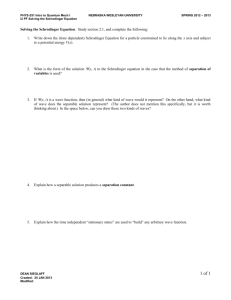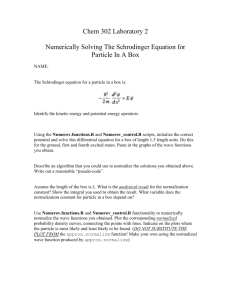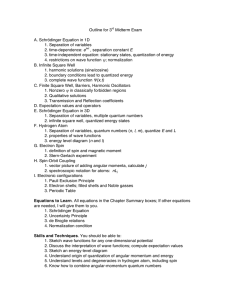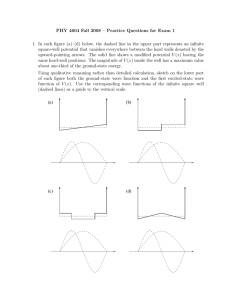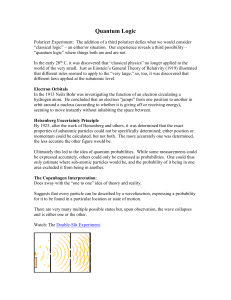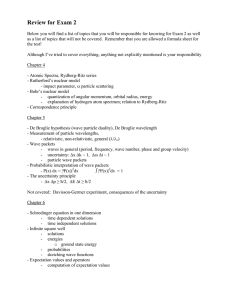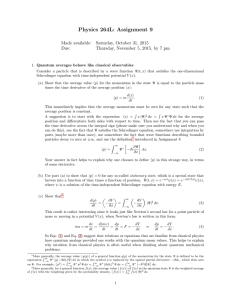PHYS 2D DISCUSSION SECTION 2012/5/30
advertisement
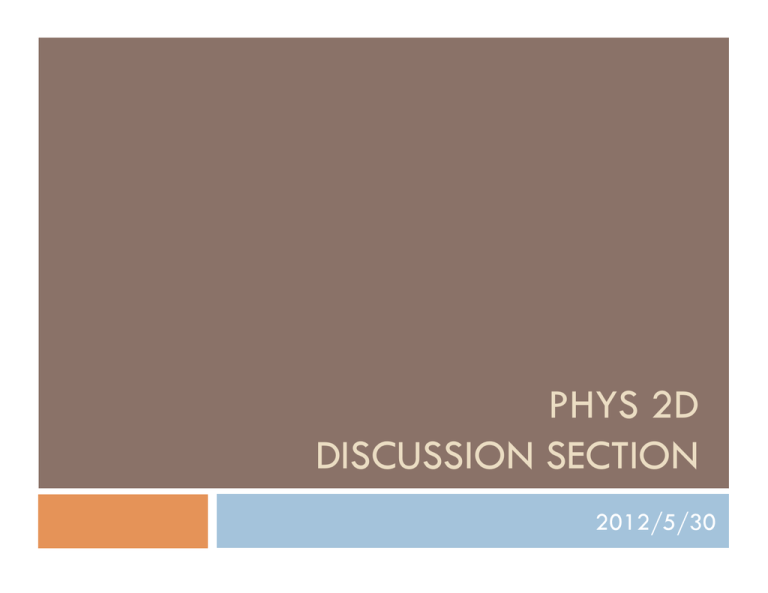
PHYS 2D DISCUSSION SECTION 2012/5/30 Quiz this Friday QM in 3D (math really) More Realistic QM Our world is 3 dimensional Must use 3 coordinates Study 2 cases: Particle in a 3D box -Essentially the same thing Hydrogen atom -Spherical coordinates, very different Particle in a 3D box Choose Cartesian coordinates x, y, z Schrodinger’s equation Separation of variables 1: Ψ(x,y,z,t)=ψ(x,y,z)φ(t) Yields φ(t)=exp(-iωt), E=ħω Particle in a 3D box Separation of variables 2: ψ(x,y,z)=ψ1(x)ψ2(y)ψ3(z) Dividing by ψ(x,y,z) yields Each part must be independent of coordinates, so Particle in a 3D box We have essentially three 1D problems ψ1=Asink1x=Asin[(n1π/L)x] ψ2 =Bsink2y=Bsin[(n2π/L)y] ψ3 =Csink3z=Csin[(n3π/L)z] E=E1+E2+E3 Particle in a 3D box Ψ(x,y,z,t)=ψ(x,y,z)φ(t)=ψ1(x)ψ2(y)ψ3(z)φ(t) Normalization: ki=niπ/L Need 3 “quantum numbers” n1n2n3 to specify a state Particle in a 3D box Degeneracy: If different sets of (n1, n2, n3) correspond to the same E, they are said to be degenerate states (2,2,2) (3,1,1) (2,2,1) (2,1,1) (1,1,1) Hydrogen atom Want to find wave function of the electron Wave function can be described using any 3D coordinate system U(x,y,z)~1/r The system is spherically symmetric: a positive charge at the center More natural to use spherical coordinates (r, θ, φ) than Cartesian coordinates (x, y, z) The differential equation is very different So the wave functions also look very different Steps to finding the wave function To find the wave function, method is still the same: Write out the form of the differential equation Separation of variables, Ψ(r,θ,φ,t)=R(r)Θ(θ)Φ(φ)T(t) Separate the equation into 4 parts Solve each part The 3 spatial parts will each give a quantum number Combine all 4 parts and normalize Spherical coordinates Schrodinger’s equation Multiply Schrodinger’s equation by -2m/ħ2 Separation of variables Multiply by rsin2θ/(RΘΦ) Φ(φ) Φ(φ) is the first the be separated The rest of the equation does not depend on φ, so is some constant Periodic boundary condition: Φ(φ+2π)=Φ(φ) =-(ml)2, Φ(φ)~exp(imlφ) Boundary condition Φ(φ+2π)=Φ(φ) is satisfied Θ(θ) & R(r) Now that we’ve dealt with Φ(φ) Divide by sin2θ and separate r & θ terms Some smart guy solved the θ differential equation and found that solutions exist only when Separated equations After separation, we have All solved by smart people (Legendre, Laguerre) Θ(θ) Solutions are called associated Legendre polynomials Plm(cosθ) Solutions exist only when l=0, 1, 2, … Also require ml=-l, -l+1, -l+2, …, 0, …, l-2, l-1, l Ex. l=3, ml=-3, -2, -1, 0, 1, 2, 3 R(r) Solutions are called associated Laguerre functions Solutions exist only when E>0 (continuous states) or (bound states) n=1, 2, 3, …, ∞ Happens to be what Bohr predicted Also require l=0, 1, 2, …, n-1 Quantum numbers 3D problem has 3 quantum numbers Each set of 3 q-#’s specify a state In hydrogen the set is (n, l, ml) n goes from 0 to ∞, l is restricted by n, ml is restricted by l Ex. If n=2, l=0/1, m0=0, m1=-1/0/1 1 possible state with n=1: (1,0,0) 4 possible states with n=2: (2,0,0) & (2,1,-1/0/1) 9 possible states with n=3 2 N possible states with n=N The wave functions Denote ml as m Φ(φ)=Φm(φ)~exp(imφ) m Θ(θ)=Θl,m(θ)~Pl (cosθ) R(r)=Rn,l(r) T(t)~exp(-iEt/ħ) Wave function for hydrogen Ψ(r,θ,φ,t)=Rn,l(r)Θl,m(θ)Φm(φ)T(t) We can look at for example the ground state The ground state is spherically symmetric We can define the radial probability distribution This is the probability the electron will be found at a distance [r, r+dr] from the nucleus All the l=m=0 states are spherically symmetric The excited states Orbitals

